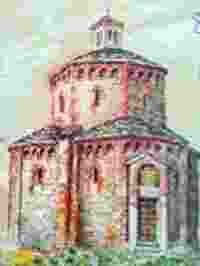Evangelist John

The apostle John was the disciple whom Jesus loved"
Antioch of Syria was born, 10 about - Thebes, 93 about).
The Christian tradition has attributed to him five New Testament texts: the Gospel according to John, the three Letters of John and the Revelation of John.
Summary:
- San Giovanni Biographical Notes
- San Giovanni Index parables
Join us
St. John Biography and life
The Apostle and Evangelist Saint John was the son of a certain Salome and Zebedee, fisherman of the lake of Galilee. He had for his brother San Santiago the Major and with him practiced his father's trade. Everything suggests that his family had a certain comfort, since his father Zebedeo had some servants at his service, and his mother Salome was one of those pious women who followed Jesus on his travels and helped him with their substances by providing him with what he needed.
Disciple of the Baptist, when he heard his teacher call Jesus "lamb of God", he wanted to go behind him to find out where he lived. While one day with his brother Santiago was fixing the nets on a boat, Jesus called them both to the Apostolate: and they left their father Zebedee in the boat with the boys, and followed him. From this moment John no longer abandoned his new Master, but was his companion during his public ministry in Galilee, Judea, until his crucifixion on Calvary.
He became one of the favorite disciples and Jesus wanted him to witness the resurrection of the daughter of Jairus, his transfiguration and his agony in the garden of Gethsemane, he commissioned him together with Peter to prepare the Easter dinner, allowed him to lay his head on his chest and to him, before dying, he inherited his mother Blessed Virgin Mary.
Full of love and zeal for Jesus he deserved to be called the son of thunder. After the Ascension of Jesus, he stayed for some time in Jerusalem and with St. Peter had the first parts in the Jerusalem Church. He was present at the miracle performed by the Prince of the Apostles on the cripple, who was sitting at the door of the temple, and with Peter himself he was imprisoned and suffered a lot from the Jews.
Later he went with St. Peter to Samaria to complete the evangelization work begun by Deacon Philip and impart the Holy Spirit to the new converts. On Paul's second trip to Jerusalem, he was in this city. In the last years of his life, due to the Christian faith, he was exiled.
St. John on the island of Patmos, where he had visions of the Apocalypse. Released from exile, he exercised supremacy over the churches of Asia Minor.
Towards the end of his life Saint John was sent to Rome, and here, as a testimony of Tertullian, he was immersed in boiling oil, but he had nothing to suffer. He was later sent into exile on the island of Patmos near Ephesus, and here he wrote the Apocalypse. Freed from exile, he returned to Ephesus, where he died in the early years of Trajan's empire.
The examination of the book fully confirms the data of the tradition. The author clearly shows that he is a Jew, although he writes in Greek, his vocabulary, his grammar and his syntax are very influenced by Aramaic. On the other hand, He knows exactly all the Jewish customs, and has exact geographical and topographical notions of both Palestine and Jerusalem.
After claiming that Jesus did many other wonders that are not recorded in the book he wrote, he adds: These things have been written, so that you believe that Jesus is the Christ Son of God, and by believing you have life in his name. In writing his Gospel, St. John proposed to confirm his readers in the faith of the Messianity and Divinity of Jesus Christ. To this end all the pages of his book aim, in fact, since the prologue, he presents Jesus Christ as the Word and the only Son of God.
According to ancient writers, Saint John wanted to complete the narrative of the three Synoptics, writing "a spiritual Gospel", that is, placing special emphasis on what referred to the intimate nature of Jesus Christ.
St. John wrote his gospel after returning from the exile of Patmos, which leads to the year 96.
The recipients of the fourth gospel are not the Jews and not even the Christians of the first generation. The Evangelist in his book addresses adult Christians who already know the elements of the doctrine taught by the Savior, and only need to be confirmed in faith against the false doctrines spread by heretics.
John's narratives are not history properly, but a mystical contemplation of the Gospel; the discourses contained in his Gospel are theological meditations to give glory to the incarnate Word. On the other hand, it is necessary to remember that the Synoptics also present Jesus Christ as true God and true son of God, who has the power to forgive sins, which is superior to Jonah and Solomon, and is not at all bound to pay the tribute, because he is the son of the King, and that it is so great that no one can know him except the Father, while in turn he alone knows the Father, etc. From this it is deduced that between the first three Gospels and the fourth there can be no substantial divergence in the doctrine.
Saint John Parables Index
- The good shepherd
- The vine and the branches
